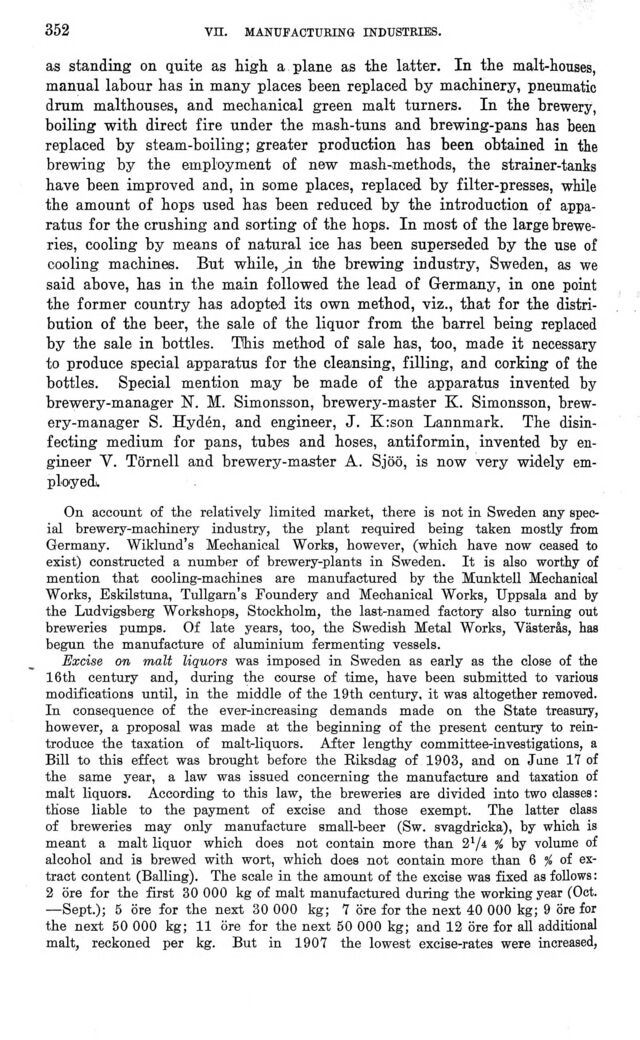
Full resolution (JPEG) - On this page / på denna sida - VII. Manufacturing Industries. Introd. by [G. Sundbärg] K. Åmark - 1. Articles of Food and Consumption. Introd. by Alf. Larson - Breweries. By P. Klason

<< prev. page << föreg. sida << >> nästa sida >> next page >>
Below is the raw OCR text
from the above scanned image.
Do you see an error? Proofread the page now!
Här nedan syns maskintolkade texten från faksimilbilden ovan.
Ser du något fel? Korrekturläs sidan nu!
This page has never been proofread. / Denna sida har aldrig korrekturlästs.
352
vn. manufacturing industries.
as standing on quite as high a plane as the latter. In the malt-houses,
manual labour has in many places been replaced by machinery, pneumatic
drum malthouses, and mechanical green malt turners. In the brewery,
boiling with direct fire under the mash-tuns and brewing-pans has been
replaced by steam-boiling; greater production has been obtained in the
brewing by the employment of new mash-methods, the strainer-tanks
have been improved and, in some places, replaced by filter-presses, while
the amount of hops used has been reduced by the introduction of
apparatus for the crushing and sorting of the hops. In most of the large
breweries, cooling by means of natural ice has been superseded by the use of
cooling machines. But while, in the brewing industry, Sweden, as we
said above, has in the main followed the lead of Germany, in one point
the former country has adopted its own method, viz., that for the
distribution of the beer, the sale of the liquor from the barrel being replaced
by the sale in bottles. This method of sale has, too, made it necessary
to produce special apparatus for the cleansing, filling, and corking of the
bottles. Special mention may be made of the apparatus invented by
brewery-manager N. M. Simonsson, brewery-master K. Simonsson,
brew-ery-manager S. Hydén, and engineer, J. K:son Lannmark. The
disinfecting medium for pans, tubes and hoses, antiformin, invented by
engineer Y. Törnell and brewery-master A. Sjöö, is now very widely
employed.
On account of the relatively limited market, there is not in Sweden any
special brewery-machinery industry, the plant required being taken mostly from
Germany. Wiklund’s Mechanical Works, however, (which have now ceased to
exist) constructed a number of brewery-plants in Sweden. It is also worthy of
mention that cooling-machines are manufactured by the Munktell Mechanical
Works, Eskilstuna, Tullgarn’s Foundery and Mechanical Works, Uppsala and by
the Ludvigsberg Workshops, Stockholm, the last-named factory also turning out
breweries pumps. Of låte years, too, the Swedish Metal Works, Västerås, has
begun the manufacture of aluminium fermenting vessels.
Excise on malt liquors was imposed in Sweden as early as the close of the
16th century and, during the course of time, have been submitted to various
modifications until, in the middle of the 19th century, it was altogether removed.
In consequence of the ever-increasing demands made on the State treasury,
however, a proposal was made at the beginning of the present century to
reintroduce the taxation of malt-liquors. After lengthy committee-investigations, a
Bill to this effect was brought before the Riksdag of 1903, and on June 17 of
the same year, a law was issued concerning the manufacture and taxation of
malt liquors. According to this law, the breweries are divided into two classes:
those liable to the payment of excise and those exempt. The latter class
of breweries may only manufacture small-beer (Sw. svagdricka), by which is
meant a malt liquor which does not contain more than 2l/i % by volume of
alcohol and is brewed with wort, which does not contain more than 6 % of
extract content (Balling). The scale in the amount of the excise was fixed as follows:
2 ore for the first 30 000 kg of malt manufactured during the working year (Oct.
—Sept.); 5 ore for the next 30 000 kg; 7 ore for the next 40 000 kg; 9 ore for
the next 50 000 kg; 11 ore for the next 50 000 kg; and 12 ore for all additional
malt, reckoned per kg. But in 1907 the lowest excise-rates were increased,
<< prev. page << föreg. sida << >> nästa sida >> next page >>